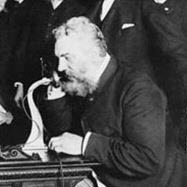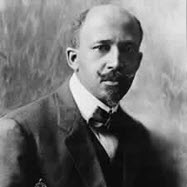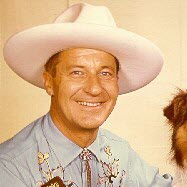Inventor, Baseball Star, Singing Cowboy Among Them
Alexander Graham Bell
He is most famous as an inventor and for his work with new technology in the late 19th century, most notably the telephone. Bell’s scientific interests also extended, unsurprisingly, to those with hearing impairments. Bell had previously worked as a teacher to deaf students, and married a former deaf student named Mabel. In 1900, Bell worked on a special census report on the nation’s deaf, mute and blind. For this report, Bell implemented many changes to previous survey methods, such as phrasing questions properly to encourage accurate responses. Learn more about Bell and the census.

William Edward Burghardt Du Bois

He used his gifts as a social scientist and writer to fight for equal rights for black Americans throughout his life. In 1904, Du Bois wrote an analysis of black farmers in the southern United States. Du Bois’ analysis used statistics to counter the racist narrative of the day and showed how black farmers used their land and agricultural skills to make a better life for themselves and their families. Access Du Bois’ report [PDF 14 MB, page 68] or more census reports and publications.
John Joseph “Black Jack” Pershing
He advanced his way to the highest rank in the U.S. Army. As a career soldier, General Pershing served in many campaigns, from the Spanish-American War during which he earned his nickname as commanding officer of the Buffalo Soldiers, to the hunt for Pancho Villa through Northern Mexico. He is most famous for his campaign across the blasted battlefields of Europe during World War I. General Pershing also fought in the Philippines and served as military governor of the Iligan district there. During the 1903 Census of the Philippines, Pershing, one of the few men respected by the local Moros, served as census supervisor for his district. Learn more about General Pershing and the census.

Shirley Anita Chisholm

She broke conventions and wrote history as the first black woman elected to the U.S. Congress in 1968. Throughout her long career in public service, including 14 years in the U.S. House of Representatives, Chisholm looked out for those whom the government traditionally overlooked and neglected. In 1970, Chisholm worried about minorities being underrepresented in the census and pinned on an enumerator’s badge to help enumerate parts of Brooklyn — showing that the census could benefit communities simply by counting them. Learn more about 1970 Census and concerns about an undercount.
Lafayette Parker “Pick” Temple
He was best known for "The Pick Temple Giant Ranch" television show that aired from 1948 through 1961. His children's show featured his guitar playing and singing, puppet shows, cartoons, his pony Piccolo, and Lady, his faithful Collie canine companion. Prior to his career in show business, Temple was an economic statistician in the Business Division of the U.S. Census Bureau. Learn more about Pick and other notable census alumni.

Thomas Jefferson

He is most famous as the third president of the United States and as the author of the Declaration of Independence, also served as George Washington's first secretary of state. As the nominal director of the first census in 1790, Jefferson certified the combined local results reported by each marshal. He also shared President Washington's concern that the census had significantly undercounted the population, perhaps by as much as several hundred thousand residents. Learn more about Thomas Jefferson or learn more about the 1790 Census.
Kirby Puckett
He was a major league slugger who won two World Series with the Minnesota Twins in 1987 and 1991. Before he became famous on the baseball diamond, Kirby worked as a temporary census employee for the 1980 Census in Chicago. Learn more about the 1980 Census.

(Photo from Wikipedia.com)
Bernard Malamud

The Pulitzer-Prize-winning author is most famous for The Fixer, a novel that won the National Book Award and Pulitzer Prize, as well as his baseball novel The Natural that was made into a popular film. Before writing full time, Bernard worked in the Agricultural Division of the U.S. Census Bureau in 1940 where he wrote short stories on his lunch break. Learn more about Bernard Malamud or other notable census alumni.
Wilbur Ross, Former Secretary of Commerce
He supervised the U.S. Census Bureau as the head of the Department of Commerce. Before rising to the top, Secretary Ross served as an enumerator during the 1960 Census while still in school. Learn about Secretary Ross’s enumerator experience or see his profile.

Subscribe
Our email newsletter is sent out on the day we publish a story. Get an alert directly in your inbox to read, share and blog about our newest stories.
Contact our Public Information Office for media inquiries or interviews.
-
GovernmentLocal Governments Step Up to Help Count Their CommunitiesApril 26, 2018By participating in the Local Update of Census Addresses operation (LUCA), governments help ensure communities receive their fair share of federal money.
-
PopulationWho Knew? A Census Taker Could Come KnockingApril 04, 2018Is this really a Census worker? Go to this podcast to hear how you can make sure.
-
PopulationCensus Questions Keep Up With the TimesDecember 21, 2017Reflecting societal changes, testing supports dropping terms such as "trolley bus" and "handheld computer."
-
Business and EconomyState Governments Parlay Sports Betting Into Tax WindfallDecember 10, 2025Total state-level sports betting tax revenues has increased 382% since the third quarter of 2021, when data collection began.
-
EmploymentU.S. Workforce is Aging, Especially in Some FirmsDecember 02, 2025Firms in sectors like utilities and manufacturing and states like Maine are more likely to have a high share of workers over age 55.
-
PopulationTribal Casinos: An Economic BoonNovember 20, 2025A new study explores how tribal casino expansion in the 1990s and 2000s affected poverty, jobs and income for American Indian communities and their neighbors.
-
NAICS Sector 31-33 ManufacturingSome Less Populous States Have High Manufacturing Revenue Per CapitaSeptember 29, 2025Today is the start of a week of celebrations at the Census Bureau marking the 14th annual Manufacturing Day on October 3.




